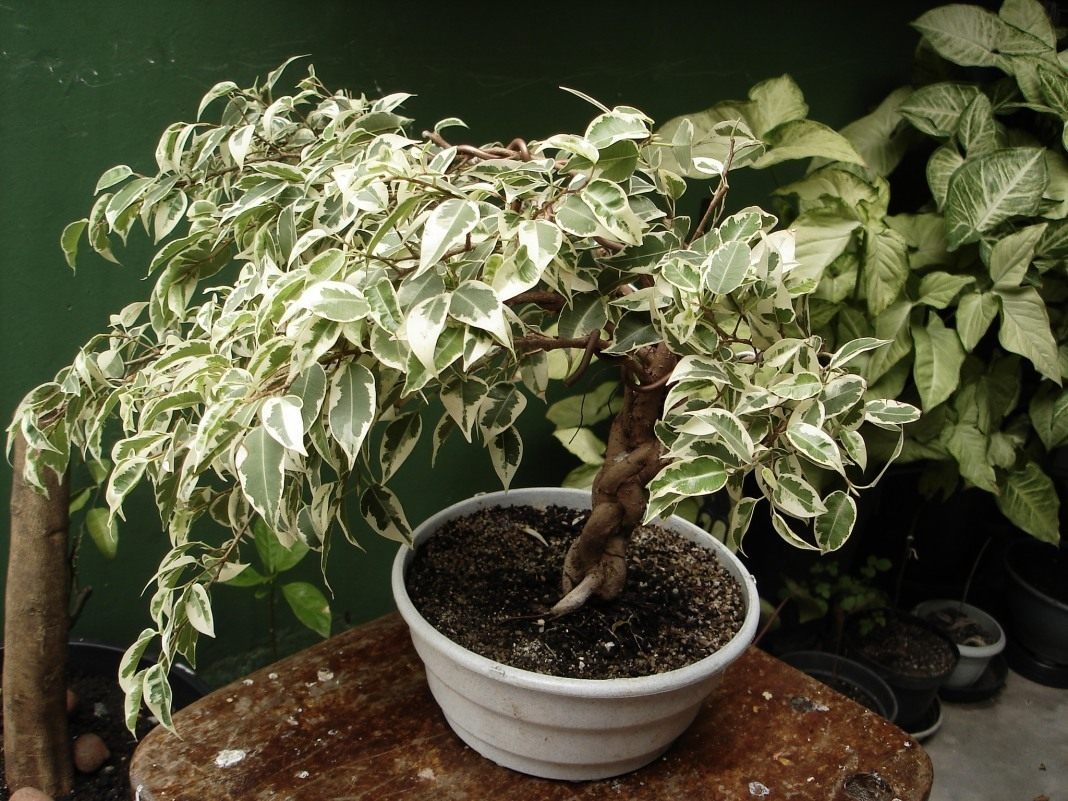Among all the variety of indoor plants, the ficus is very popular, which can be an excellent decoration for a winter garden or living quarters. Some people almost attribute magical properties to ficuses.
Information has reached our days that this plant can maintain clean air in the room, eliminate negative emotions and negative energy, and also keep the idyll of family life in the house.
A very interesting variety is Benjamin's ficus, which is perceived by many flower lovers as a plant that can lure wealth and prosperity into the house. But most often this plant is started for decoration, because it stands out for its decorative properties, besides, many people appreciate the availability and unpretentiousness of care in it.
Content
Description of Ficus Benjamin
 In nature, you can often find specimens of Benjamin's ficus, which reach 25 meters in height. The characteristic feature of the plant is dark gray bark, which is decorated with transverse brown strokes.
In nature, you can often find specimens of Benjamin's ficus, which reach 25 meters in height. The characteristic feature of the plant is dark gray bark, which is decorated with transverse brown strokes.
Small petioles decorate oblong leaves with a pointed top. Having a smooth glossy shape, the leaves are arranged on the shrub in an alternating order. They are small in size, reaching 4-12 cm in length and 3-6 cm in width.
The central vein is most clearly seen in the leaves against the background of 8-12 pairs of weakly expressed lateral veins. The root system has invasive formation.
In different Benjamin ficuses, the roots can grow not only vertically, but also horizontally. Indoor specimens are able to form a sufficiently developed root system.
Ficus genus Benjamin provides many varieties, which differ from each other in size, shape, color of leaves, as well as in the nature of adaptability to growing in certain conditions. All these nuances must be considered when choosing a Benjamin ficus.
Plant care
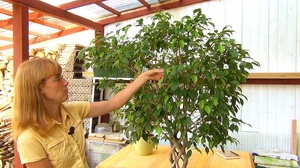 This houseplant will develop well only if there are favorable conditions created.
This houseplant will develop well only if there are favorable conditions created.
Watering. Ficus Benjamin is not a plant that can grow and thrive if watered on a tight schedule. It is necessary to plan this event taking into account such factors as the age of the ficus, lighting, air humidity, temperature and season.
It is also very important to water in moderation. A sign that the time has come for the next watering is the drying out of the earth to a depth of 2-3 cm.
It is necessary to grow ficus Benjamin in pots with drain hole, through which excess moisture can go into the sump, from where it can be drained.
In winter, watering the Benjamin ficus should not be too frequent. At this time of the year, due to low activity, the plant requires a minimum amount of moisture.
During care, it is useful to combine watering with feeding, for which you can add water to the water prepared for irrigation liquid mineral fertilizers.
This plant responds positively to a warm shower, which must be carried out every two to three weeks. To do this, the flower must be transferred to the bathroom, cover its soil layer with a film, and then spill it thoroughly with a stream of water.
Lighting and temperature for the plant
Proper care of Benjamin's ficus involves ensuring maximum illumination. Indeed, with its lack, changes in the color of the leaves and the general condition of the ficus are possible. In terms of lighting, a number of requirements can be distinguished that must be met:
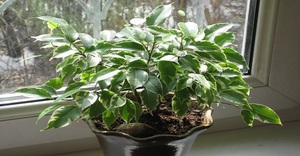 Good lighting. It is recommended to grow Benjamin's ficus in the brightest and most well-lit places.
Good lighting. It is recommended to grow Benjamin's ficus in the brightest and most well-lit places.- The ability to protect the plant from direct sunlight.
- In some cases, the flower can grow normally in diffused light or partial shade, however, this only applies to varieties of ficus with dark green leaves.
Ficus Benjamin feels best at a temperature of 20-25 degrees... At the same time, drafts, hypothermia from windows, window sills and open vents cause growth retardation.
In winter, a significant decrease in the temperature regime to 16-18 degrees is allowed, which does not cause serious harm to the plant.
Air humidity
 You can provide comfort to Benjamin's ficus at home by creating high humidity for it. First of all, you need to take care of this in the summer.
You can provide comfort to Benjamin's ficus at home by creating high humidity for it. First of all, you need to take care of this in the summer.
For this purpose, it is necessary to regularly carry out spraying the crown plants. The best effect is provided by settled water cooled to room temperature.
In winter, the flower should be kept as far as possible from the heating system devices. It is useful to place devices near the ficus that help maintain the required air humidity. They can also be replaced with a regular can of water.
Benjamin's ficus will grow best if an air humidity of 70% is provided for it. Also, this houseplant responds positively to feeding. They must be carried out every spring and summer at intervals of 2-3 weeks.
Moreover, it is necessary to apply to the soil one by one and mineral and organic fertilizers... In the spring, when the plant enters the active growth phase, it is recommended to apply nitrogen-rich fertilizers to the soil.
Ficus transplant
Necessity ficus benjamin transplants usually occurs in the following cases:
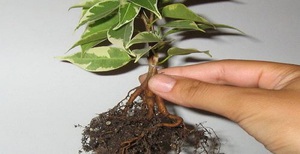 lack of space in the pot for a mature plant;
lack of space in the pot for a mature plant;- the roots completely enveloped the earthy lump;
- the plant needs fertilization or improved drainage;
- during the propagation of the plant.
To avoid difficulties with growing Benjamin ficus, it is recommended to transplant it once a year... It is best to plan it in the spring.
Transplant specimens aged 4 years and older can be carried out every two to three years. In the summer, it is necessary to renew the topsoil in the pot from time to time.
When transplanting young plants, it is recommended to fill a new container with leafy soil or universal soil primerwhich is offered in specialty stores. Older specimens require dense nutrient soil.
Tank and soil preparation, transplant rules
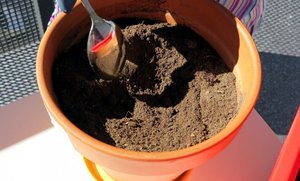 It is very important for transplanting to choose the right pot, which should be fit the plant and not be cumbersome. To do this, you need to proceed from the fact that the new container should be 2-3 cm wider than the previous one.
It is very important for transplanting to choose the right pot, which should be fit the plant and not be cumbersome. To do this, you need to proceed from the fact that the new container should be 2-3 cm wider than the previous one.
Before filling the soil, there is good drainage at the bottom of the pot. You also need to pay attention to the fact that the prepared soil must have a neutral acidity reaction (ph = 5.5-6.5). All other substrates will negatively affect the plant, therefore recommended to avoid use for transplanted ficus alkaline soil and with high acidity.
When transplanting a plant, you need to do everything possible to injure the root system as little as possible. The easiest way to achieve this is if use the transshipment method.
With its help, you can transfer the old earthen lump to a new pot, preserving its integrity as much as possible. Then, after transplanting, the flower quickly takes root and begins to grow.
During the transfer the plant cannot be watered, after its completion, it is necessary to withstand the "dry" mode for two days, after which the watering is resumed. If this event is held in the summer, when the room is rather hot and stuffy, then you can spray the plant to increase the humidity.
If we are talking about a recently purchased plant, then it is recommended to transplant in 3-4 weeks. By this time, he will be able to adapt as much as possible to lighting, humidity, temperature, so the transplant does not become a serious test for him.
Reproduction of ficus Benjamin
 Plants that were propagated using cuttings demonstrate the best survival rate. Shoots form roots rather quickly, for which they can be placed into water or soil.
Plants that were propagated using cuttings demonstrate the best survival rate. Shoots form roots rather quickly, for which they can be placed into water or soil.
In the first case, it is necessary to ensure that the water is constantly fresh. If the propagation method is used through planting cuttings in the ground, it is recommended to install a jar on the container in order to maintain the greenhouse effect. Before placing the cutting into the soil, the cut site is washed with warm water.
Experts recommend breeding Benjamin ficus in spring or early summer... This can be explained by the fact that it is at this time of the year that the plant enters the active phase of the formation of roots and foliage.
The strongest flowers are obtained if used for reproduction. stalk with 2-3 knots with leaves. It is not recommended to use a cutting that is too large or small, as it will have less chances to quickly adapt and take root.
In a slightly different way leaf propagation of ficus... To do this, first, a sheet is harvested at the lowest part of the trunk and transferred to a jar of water. It is imperative to add acetylsalicylic acid or activated carbon to it in order to prevent decay.
In some cases, it is allowed to grow a ficus leaf in the ground. However, in order for it to take root well, it is necessary to maintain favorable conditions in the container where it grows - temperature, lighting and humidity.
Crown formation, ficus pruning
Pruning is a popular method that allows you to shape Benjamin's ficus into the desired shape. Most often, the following types of crown formation are used for these plants:
 Spherical crown shape.
Spherical crown shape.- Bushy.
- In the form of a single - or multi-tiered trunk.
- Bonsai style.
- In the form of various sculptures.
Experts recommend planning for pruning ficus in spring or early summer, because it is at this time of the year that its accelerated growth begins.
When forming a crown, it is necessary take into account the age of the plant... The easiest way is to give the desired crown shape in young specimens. This, in turn, is a guarantee that as a result of pruning, the plant will acquire the desired shape.
Pruning Ficus Benjamin usually considered in relation to those plants that have a sufficiently overgrown crown, or specimens that, due to their unusually large size, have lost their former attractiveness.
So that after pruning Benjamin's ficus not to face unpleasant consequences, it is necessary to carry out this operation, taking into account the following rules:
- try to make sure that after the operation the plant does not lose its naturalness;
- before removing the branches, try to imagine how the ficus would look without them;
- it is necessary to remove branches only with a sterile instrument;
- it is necessary to keep the bark intact;
- during pruning of ficus, care must be taken to ensure that the leaves are not damaged;
- ficus branches must be removed at an angle to the upper edge.
How to braid ficus trunks
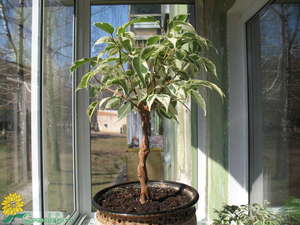 Crown formation is not the only method that allows return the plant to its former attractiveness... Another method is table weaving.
Crown formation is not the only method that allows return the plant to its former attractiveness... Another method is table weaving.
To do this, you will have to choose a couple of young specimens with a similar thickness and height of the tables, which are subsequently transplanted into a common pot.
Since in such plants the trunks become semi-lignified and at the same time retain their flexibility, then their you can easily weave... Where the side shoots will connect, it is imperative to cut off all the leaves.
When creating the spiral and pigtails, you need to leave a lot of space, counting on the subsequent thickening of the trunks. A favorable time for the beginning of the plexus of the trunks occurs when the lower part of the flower grows to 13 cm.
Ficus Benjamin is one of the brightest representatives of the ficus family, which has retained all the best qualities of this houseplant.
Growing it at home is enough a simple eventhowever, there are some points regarding leaving.
First of all, you need to pay attention to the fact that the plant needs replant periodically into a new container. If it is important for the owner to maintain the decorative properties of Benjamin's ficus, then he will have to regularly prune the branches.


